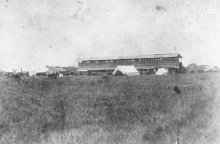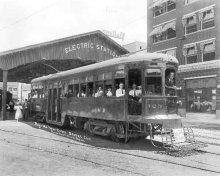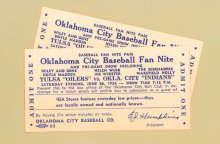Description:

No one is sure when or where the first game of baseball was played in Oklahoma City, but in the summer of 1889, teams had formed up and enough citizens were eager to watch that two temporary grandstands were built for fans – one on the west side and one on the east. We also know that baseball was played at one of the first citywide celebrations – Independence Day, 1889. A permanent grandstand was built at the fairgrounds on the northeast side in 1890. Over the next decade various teams formed and played either as loose clubs or company teams, but the first formal professional baseball team in the city was the Metropolitans (Mets) which played in the Southwestern League in 1904. The team played in Colcord Park, a ballpark which was part of the very popular Delmar Garden entertainment area just off Western Ave. on the banks of the river. The Mets were Oklahoma City’s team until 1917 when the team disbanded due to World War I. The team was very popular among fans and street cars (the only way to get to the park besides walking) would actively promote games by providing special express cars on game days. In 1918, John Holland, a longtime baseball man with the Mets formed a new team for the 1919 season and built a new park – Western League Park – on Exchange Avenue just across the river from the old park. The new team, the Indians, played there until the river washed away Wheeler Park Zoo,

Western League Park and a number of other buildings in a devastating flood. By the 1924 season-opener, they were installed in new Holland Field at NW 4 and Pennsylvania; the Indians would remain there until folding in 1958. The new field was a modern park for its day with a parking lot and street car access and in 1930 the first night game was played. From 1918 to 1958 the team played in the Western and then Texas Leagues and many future major leaguers and Hall of Famers would play in Holland Field including Carl ‘The Meal Ticket’ Hubbard and Rogers Hornsby was manager of the Indians in 1940-1941. In 1949, the Indians were purchased by the great baseball showman Bill Veeck as a farm team for his Cleveland Indians in the American League. Many of Oklahoma City’s players, such as Al Rosen and Dale Mitchell, went on to play for the big league club and formed key parts of their 1948 and 1954 World Series teams. By 1958 the Oklahoma City Indians were no longer associated with the Cleveland Indians and falling on financial hardtimes, the team folded. Three years later a new team was formed and a new ballpark – All-Sports Stadium – was built at the new Fairgrounds at NW 10 and Portland. The team was a farm club for the new Houston Colt .45s in the National League and over the next four decades the team would be associated with Houston, Cleveland again, Philadelphia and finally, Texas. Even though they may not have played professionally in Oklahoma City, a number of other great major

leaguers have come from Central Oklahoma. Three Hall of Famers were born in the area, brothers Paul ‘Big Poison’ Waner and Lloyd ‘Little Poison’ Waner from Harrah and Johnny Bench in Oklahoma City. Wilbert ‘Bullet’ Rogan, from Oklahoma City, is also in the Hall of Fame. Because of segregation he never made it to the Major Leagues, but those who saw him pitch for the Kansas City Monarchs in the Negro Leagues said he was better than Satchel Paige. Allie ‘The Super Chief’ Reynolds from Bethany and Joe Carter from Oklahoma City were All-Stars who just missed getting into Cooperstown. Other great players from around the state were Hall of Famers, Mickey Mantle from Commerce; Carl Hubbell from Meeker; Warren Spahn from Hartshorne; Willie Stargell from Earlsboro; Iron Joe McGinnity lived near McAlester;and Dizzy Dean lived in Spaulding. Notables who missed the Hall of Fame are Carl Mays, who threw the only pitch that killed a man and lived in Kingfisher, and Pepper Martin, the ‘Wild Horse of the Osage’, from Temple was the ringleader of the famed St. Louis Cardinal Gashouse Gang in the 1930s.
FURTHER READING
- Bench, Johnny, Catch You Later: the Autobiography of Johnny Bench. New York: Harper, 1979.
- Burke, Bob, Kenny A. Franks, and Royse Parr, Glory Days of Summer: the History of Baseball in Oklahoma. Oklahoma City: Oklahoma Heritage Association, 1999.
- Old Times to the Goodtimes: Oklahoma City Baseball. Oklahoma City: [s.n.], 1981?
- Robinson, Frazier, Catching Dreams: My Life in the Negro Baseball Leagues. Syracuse, N. Y.: Syracuse University Press, 1999. Robinson was a Negro Leaguer from Oklahoma City and Okmulgee.
- Sowell, Mike, The Pitch that Killed. New York: Macmillan, 1989. About Carl Mays who lived near Kingfisher. Staten, Vince, Ol' Diz: a Biography of Dizzy Dean. New York: HarperCollins, 1992.
- Wheeler, Lonnie, The Official Baseball Hall of Fame Story of Mickey Mantle. New York: Simon and Schuster, 1990.